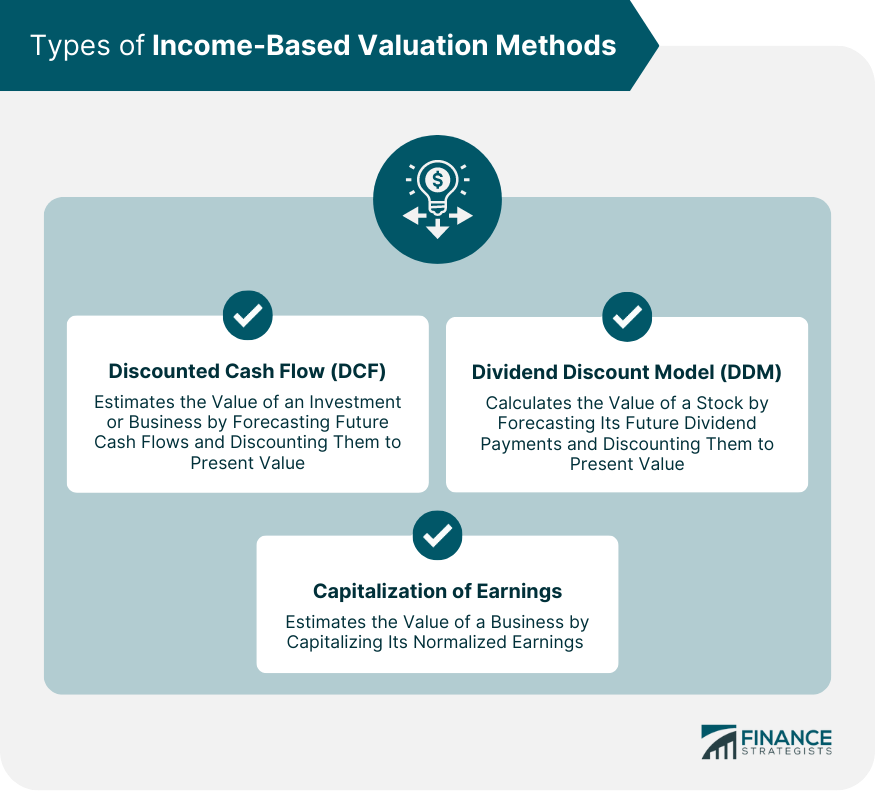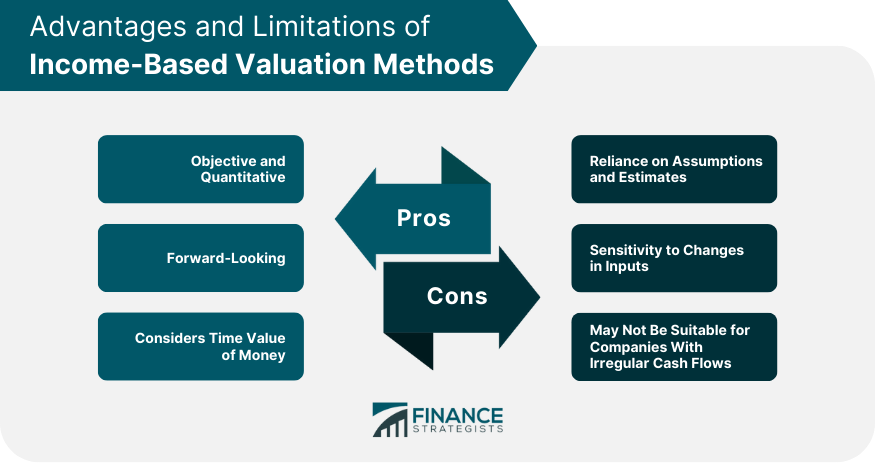Income-based valuation refers to a set of methods used to estimate the value of a business, investment, or asset based on its capacity to generate income. These valuation methods typically involve forecasting future cash flows or earnings and discounting them to present value using an appropriate discount rate. Income-based valuation methods are widely used in various financial contexts, including mergers and acquisitions, equity valuation, and investment analysis. They provide an objective framework for assessing the financial performance and growth prospects of a business, enabling investors and business owners to make informed decisions. The discounted cash flow (DCF) method is a widely used income-based valuation technique that estimates the value of an investment or business by forecasting its future cash flows and discounting them to present value. It uses a discount rate that reflects the opportunity cost of capital and the associated risks. 1. Estimate future cash flows for a specific period 2. Determine an appropriate discount rate 3. Discount future cash flows to present value 4. Sum the present values of all discounted cash flows to obtain the total DCF value The dividend discount model (DDM) is an income-based valuation method specifically designed for valuing equity investments, such as stocks. It calculates the value of a stock by forecasting its future dividend payments and discounting them to present value using a discount rate that reflects the required rate of return for the investment. 1. Estimate future dividend payments for a specific period 2. Determine an appropriate discount rate (required rate of return) 3. Discount future dividend payments to present value 4. Sum the present values of all discounted dividend payments to obtain the total DDM value The capitalization of earnings method is an income-based valuation technique that estimates the value of a business by capitalizing its normalized earnings using a capitalization rate. The capitalization rate is derived from the required rate of return and the expected growth rate in earnings. 1. Determine normalized earnings (adjusted for nonrecurring items, cyclical fluctuations, etc.) 2. Estimate the capitalization rate (required rate of return minus expected growth rate) 3. Divide normalized earnings by the capitalization rate to obtain the total capitalization of earnings value The financial performance of a company, including its revenue, expenses, and profit margins, is a critical factor in income-based valuation. Higher revenues, lower expenses, and higher profit margins generally translate to higher cash flows or earnings, leading to a higher valuation. The growth prospects of a company, such as market size, market share, and competitive advantage, also significantly influence its income-based valuation. Companies with strong growth prospects are likely to generate higher future cash flows or earnings, resulting in higher valuations. The discount rate used in income-based valuation methods reflects the risk-free rate and the company's risk premium. A higher discount rate will result in a lower present value of future cash flows or earnings, leading to a lower valuation. Income-based valuation methods provide an objective and quantitative framework for assessing the value of a business or investment, making them a popular choice among financial professionals. Income-based valuation methods are forward-looking, as they rely on projections of future cash flows or earnings. This approach enables investors and business owners to account for the potential growth and risks associated with a business or investment when determining its value. These valuation methods incorporate the time value of money, acknowledging that cash flows or earnings generated in the future are worth less than those received today. This principle is important in accurately estimating the value of a business or investment. Income-based valuation methods depend on various assumptions and estimates, such as future cash flows, earnings, and discount rates. Inaccurate or overly optimistic assumptions can lead to overvaluation, while overly pessimistic assumptions can result in undervaluation. The valuation results obtained through income-based methods are sensitive to changes in inputs, such as cash flow projections and discount rates. Small changes in these inputs can lead to significant variations in the valuation outcome, which may affect decision-making. Income-based valuation methods may not be appropriate for companies with irregular or unpredictable cash flows, as it can be challenging to accurately forecast future cash flows or earnings for such businesses. The choice of the appropriate income-based valuation method depends on the nature of the business being valued. For example, the DCF method is suitable for companies with predictable cash flows, while the DDM is more appropriate for valuing stocks that pay regular dividends. Reliable financial data is essential for conducting accurate income-based valuations. The availability of such data may influence the choice of the valuation method. Industry norms and standards may also dictate the choice of the valuation method. Certain industries may favor specific valuation methods based on historical practices or the unique characteristics of businesses operating within that industry. Income-based valuation methods play a crucial role in investment and business decision-making, as they provide an objective and quantitative framework for assessing the financial performance and growth prospects of a business. By incorporating future cash flows or earnings and considering the time value of money, these valuation methods enable investors and business owners to make informed decisions based on the potential value of a business or investment. While income-based valuation methods offer several advantages, they also have inherent limitations, such as reliance on assumptions and sensitivity to changes in inputs. To obtain accurate valuations, it is essential to balance these advantages and limitations by selecting the appropriate valuation method, considering the nature of the business, the availability of reliable financial data, and industry norms and standards.What Is Income-Based Valuation?
Types of Income-Based Valuation Methods
Discounted Cash Flow (DCF) Method
Key Components of DCF
Steps in Calculating DCF
Dividend Discount Model (DDM)
Key Components of DDM
Steps in Calculating DDM
Capitalization of Earnings Method
Key Components of Capitalization of Earnings
Steps in Calculating Capitalization of Earnings

Factors Influencing Income-Based Valuation
Company's Financial Performance
Company's Growth Prospects
Discount Rate
Advantages of Income-Based Valuation Methods
Objective and Quantitative
Forward-Looking
Considers Time Value of Money
Limitations of Income-Based Valuation Methods
Reliance on Assumptions and Estimates
Sensitivity to Changes in Inputs
May Not Be Suitable for Companies With Irregular Cash Flows

Choosing the Appropriate Income-Based Valuation Method
Nature of the Business
Availability of Reliable Financial Data
Industry Norms and Standards
Conclusion
Income-Based Valuation FAQs
Income-based valuation is a method used to estimate the value of a company based on its expected future income streams. This approach involves analyzing a company's historical financial data and making projections about its future earnings potential to determine its present value.
Income-based valuation differs from other valuation methods, such as market-based valuation or asset-based valuation, because it focuses on a company's potential to generate income in the future rather than its current market value or tangible assets.
The key components of income-based valuation are the expected future income streams, the expected growth rate of those income streams, and the required rate of return for investors. These factors are used to calculate the present value of a company's expected future income streams.
Common income-based valuation techniques include discounted cash flow analysis, capitalization of earnings, and price-to-earnings ratio analysis. Each of these methods involves making projections about a company's future earnings potential and calculating its present value based on those projections.
One limitation of income-based valuation is that it relies on assumptions about a company's future earnings potential, which can be difficult to predict with certainty. Additionally, this approach may not account for certain intangible factors, such as a company's brand reputation or intellectual property, which can also affect its value.
True Tamplin is a published author, public speaker, CEO of UpDigital, and founder of Finance Strategists.
True is a Certified Educator in Personal Finance (CEPF®), author of The Handy Financial Ratios Guide, a member of the Society for Advancing Business Editing and Writing, contributes to his financial education site, Finance Strategists, and has spoken to various financial communities such as the CFA Institute, as well as university students like his Alma mater, Biola University, where he received a bachelor of science in business and data analytics.
To learn more about True, visit his personal website or view his author profiles on Amazon, Nasdaq and Forbes.















